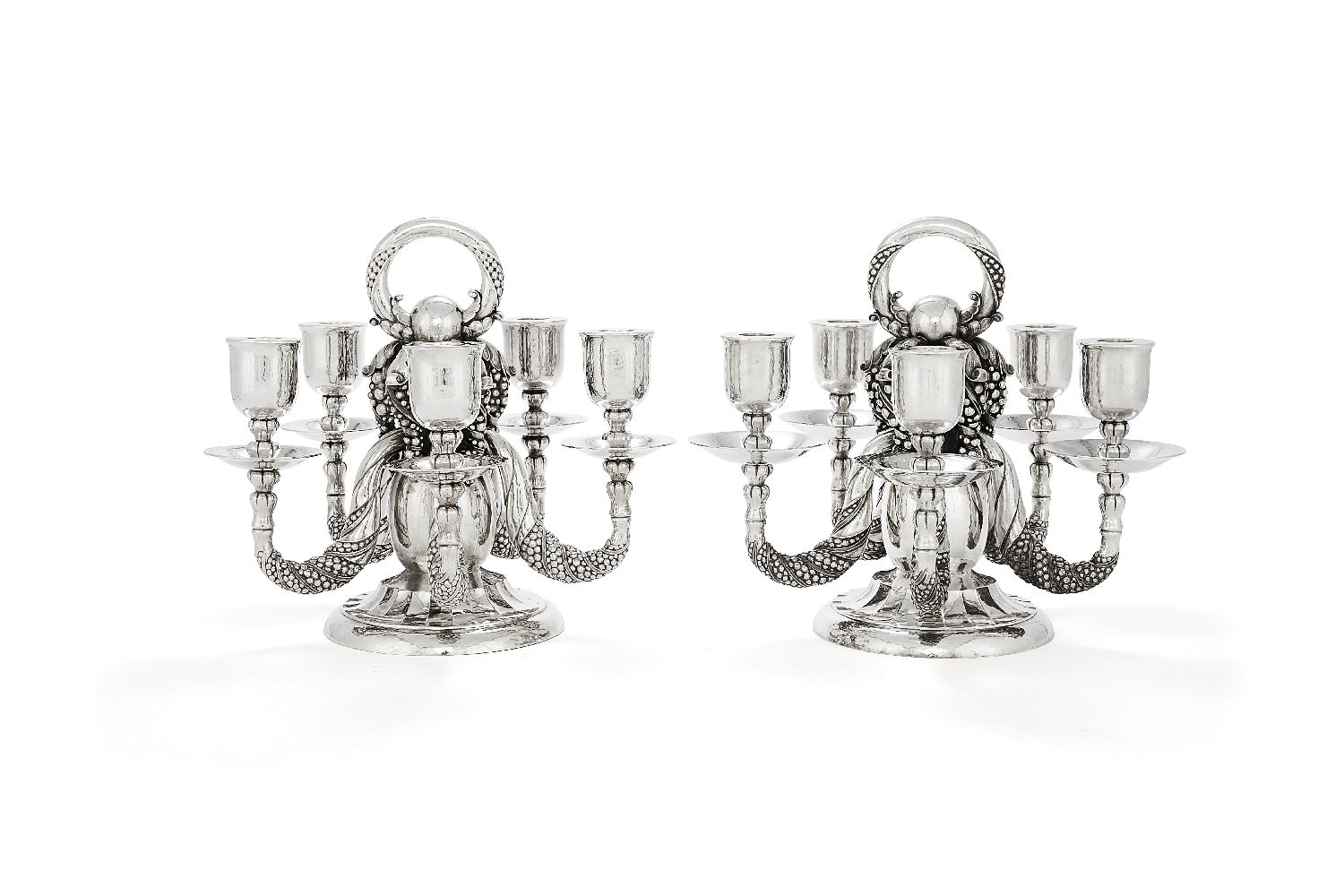Georg Jensen Silver & Jewellery: History & Valuations
Pieces of Georg Jensen silver are highly valuable and collectable. If you own a piece of Georg Jensen silver and would like to find out more about the pioneering silversmith, please read our history section at the bottom of this page.
If you are considering selling your piece, please use the form on this page for a free valuation on your Georg Jensen silver and impartial information on selling.
The Market for Georg Jensen silver in 2024
The market for Georg Jensen, especially that of Georg Jensen silver, has grown steadily over the years. The infamous silversmith helped to shape the landscape of Scandinavian design as it is today.
There is now more than ever an appreciation of the role of the artist or maker, with people buying pieces of Georg Jensen silver simply because of the name that it bears. It is a testament to the value of this silversmith’s timeless work.
More than ever condition is key and collectors discriminate against even the smallest imperfection.

Find Me A Specialist Georg Jensen Valuer
With over 150 auctioneers in the UK, choosing the right one can be daunting.
Our service connects you with the ideal specialist, ensuring accurate valuations and sales assistance.
Leveraging over fifteen years of industry experience, we match your items with the auctioneers most likely to achieve the highest prices, maximising your chances of a successful sale.
The valuers we work with have been carefully selected based on their reputation, specialty areas, and success rates. We work closely with them to market your items effectively and attract the right buyers.
If you would like a free, no obligation valuation from an expert silver valuer please use the contact form below. It’s a simple as 1, 2, 3.
1. Send details about your item
Fill out the contact form below
2. We match your item to a specialist in their field
We will send the details about your silver to a specialist who will be able to provide you with an expert valuaiton.
3. They will contact you direct using the details you provide in the contact form below
Free Expert Georg Jensen Valuations
Use the form below or send images of your Georg Jensen to be connected with a silver expert.
"*" indicates required fields
A History of Georg Jensen silver
The name Georg Jensen is well-known and respected in the fields of silversmithy and jewellery. The Danish designer and silversmith had a profound effect on the market for such items throughout his career. By the 1920s, Georg Jensen had shops all over Europe. His story, however, began in a small town north of Copenhagen.
Jensen was born in Radvad, a small town north of Copenhagen, to a knife factory grinder and a housemaid. His family noticed his gift for creativity when Jensen was very young, due to the fact that he would spend his time at a nearby clay pool, fashioning sculptures from the clay. His family nurtured his creativity, and at the age of 14, Jensen travelled to Copenhagen to become an apprentice goldsmith. He took on additional hours training on Sundays, eventually gaining entry to the Royal Academy of Art in Copenhagen.
At this point in his life, Jensen had a passion for sculpting. This early passion would influence his work as a silversmith later in life. In 1891, a piece of Jensen’s work was exhibited at the Charlottenborg annual exhibition.
Jensen became good friends with Johan Rohde, a painter, designer, architect, sculptor, and writer. Rohde founded an alternative exhibition with Joakim Skovgaard, named den Frie Udstilling. This exhibition was meant to challenge the traditional values of Charlottenborg.
Jensen exhibited a piece at the 1900 World’s Fair in Paris. After this, Jensen spent two years travelling around Europe. He was highly influenced by Art Nouveau during his travels and returned to Copenhagen with new creative visions. He aspired to create beautiful, handmade, and useful objects, as opposed to mass-produced products that were being made increasingly by machines. In a time of industrial growth, this was a difficult venture to undertake.
On his return to Copenhagen, Jensen took a job with silversmith Mogens Baillin. Baillin nurtured Jensen’s talent and allowed him to exhibit his designs under his own name, even paying Jensen commission.
In 1904 Jensen rented a small shop in Copenhagen with a view to building a silverware business, and later that year he exhibited at the Museum of Decorative Art in Copenhagen as an independent silversmith. This exhibition put Jensen on the map, and he began selling out of stock at his small shop.
To begin with, Jensen made mostly jewellery because it was a smaller financial investment than making flatware. However, in 1905, his old friend Johan Rohde came to him with clay models of flatware that he wanted to be made out of silver. The two men were opposites in terms of character, but in terms of design, they shared the same vision. They wanted to create everyday use objects of the finest quality, and influenced by stunning Art Nouveau design. The collaboration was fruitful and soon became a permanent arrangement. One of Jensen’s most famous flatware pieces was designed by Rohde – Acorn.
Through Jensen’s third marriage his business expanded. He gained collaborators and workers for his shop. The staff grew to nine plus two apprentices. The workshop was the centre of creativity – every piece was handmade. In 1906, Jensen finished his first set of flatware, named Continental, a nod to his time travelling in Europe.
In 1909, his wife’s youngest brother, Harad Nielsen, became an apprentice engraver for Jensen, but quickly displayed a talent for design. He created the drawings from which the silversmiths worked. He began collaborating on designs with Jensen and Rohde, often creating designs so in tune with theirs that it was difficult to tell who the designer was. Harald Nielsen became one of the most famous and valued designers for Georg Jensen, even taking over as creative director upon Jensen’s death in 1935. The flatware pattern – Pyramid – is a design by Harald Nielsen.
Another famous designer that Jensen collaborated with is Gundorph Albertus, who in 1911, began to work for Jensen, learning every kind of craft in the business. Later, he became an advisor deputy director of the silversmithy, responsible for quality control. The designs Cactus and Mitra were designed by Albertus.
Between 1907 and 1918, the business thrived, and Jensen was the happiest he had ever been in his third marriage. The marriage was also opportune as it provided workers for his shop – his wife’s sister became the bookkeeper.
In 1916 Jensen created his company GEORG JENSEN SOLVSMEDIE A/S (GEORG JENSEN SILVERSMITHY LTD.) and sold shares in the firm to fund the increasing production. Danish engineer P.A. Pederson and Thorolf Moller bought huge shares in the company as they were admirers of Jensen’s work.
By 1918, Jensen had 125 staff and had to move to larger premises. In 1918 Jensen, Nils Wendel and Thorolf Moller formed a joint-stock company called Aktieselskabet Georg Jensen & Wendel, and strived to build a new shop that was as elegant as the stock they produced. The shop was designed by Rohde. Plans were made for shops to be built in Paris and London.
In 1919, as the business grew, P.A. Pedersen took over the chairmanship of the company. Thorolf Moller and Nils Wendel joined the board of the Silversmithy. Georg Jensen remained artistic leader.
In 1923 a Georg Jensen store was opened in New York, and sales boomed. Jensen had cemented himself as an international success.
Despite his success, Jensen felt that his creativity was being dulled, and spent much of his time alone in his small workshop, only travelling to the large workshop when he was truly needed. This was after one year of unsuccessful living in Paris, where Jensen hoped to reconnect with his creative self.
Jensen died aged 69 in 1935. His designs are highly sought after, and his business continues to do well even today. He is one of the most celebrated silversmiths in the world. You can visit the Georg Jensen website here.
Georg Jensen had an eye for talent, just as Mogen Baillin had when he took Jensen on. Some of the most influential designers that worked for Jensen include Johan Rohde (1856-1935) Just Andersen (1884-1943) Gundolph Albertus (1887-1970) Harald Nielsen (1892-1977) Arno Malinowski (1899-1976) Count Sigvard Bernadotte (1907-2002) and Henning Koppel (1918-1981).
Selling your Georg Jensen silver with Mark Littler Ltd.

Send us details about your silver directly via email or use the form below.

We contact our international network of customers for the best offers.

If you decide to proceed with an offer we issue you with a contract.

Send us your silver. We have a fully insured courier service available.

We complete the sale with the buyer and send your funds via BACS.
Auction or Private Sale?
If you are deciding on how to sell your Georg Jensen we can have a no-obligation chat on the best options for you. We can either make a personal introduction to the best saleroom based on your location and item free of charge. Or we can look into collecting you some no-obligation offers for a private sale, which could save you considerably in commission.
In a nutshell here are the main pros and cons of each option:
- Auctions can provide an increased market exposure (when you choose the right saleroom) but their gross fees can reach as much as 50%, and the payout times can be drawn out.
- Private sales leave you in control of the price, and can be completed quickly but there is no chance of ‘buyers fever’ driving up prices.
Mark Littler Ltd. are one of the only independent advisers in the antique industry. We offer trusted, independent advice to help you sell your Jensen silver for the highest possible price.
